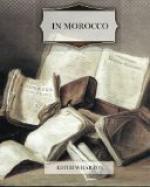Then the singing-girls would come out from Marrakech, squat round-faced young women heavily hennaed and bejewelled, accompanied by gaunt musicians in bright caftans; and for hours they would sing sentimental or obscene ballads to the persistent maddening twang of violin and flute and drum. Meanwhile fiery brandy or sweet champagne would probably be passed around between the steaming glasses of mint-tea which the slaves perpetually refilled; or perhaps the sultry air, the heavy meal, the scent of the garden and the vertiginous repetition of the music would suffice to plunge these sedentary worthies into the delicious coma in which every festive evening in Morocco ends.
The next day would be spent in the same manner, except that probably the Chleuh boys with sidelong eyes and clean caftans would come instead of the singing-girls, and weave the arabesque of their dance in place of the runic pattern of the singing. But the result would always be the same: a prolonged state of obese ecstasy culminating in the collapse of huge heaps of snoring muslin on the divans against the wall. Finally at the week’s end the wool-merchant and his friends would all ride back with dignity to the bazaar.
V
ON THE ROOFS
“Should you like to see the Chleuh boys dance?” some one asked.
“There they are,” another of our companions added, pointing to a dense ring of spectators on one side of the immense dusty square at the entrance of the souks—the “Square of the Dead” as it is called, in memory of the executions that used to take place under one of its grim red gates.
It is the square of the living now, the centre of all the life, amusement and gossip of Marrakech, and the spectators are so thickly packed about the story-tellers, snake-charmers and dancers who frequent it that one can guess what is going on within each circle only by the wailing monologue or the persistent drum-beat that proceeds from it.
Ah, yes—we should indeed like to see the Chleuh boys dance, we who, since we had been in Morocco, had seen no dancing, heard no singing, caught no single glimpse of merry-making! But how were we to get within sight of them?
On one side of the “Square of the Dead” stands a large house, of European build, but modelled on Oriental lines: the office of the French municipal administration. The French Government no longer allows its offices to be built within the walls of Moroccan towns, and this house goes back to the epic days of the Caid Sir Harry Maclean, to whom it was presented by the fantastic Abd-el-Aziz when the Caid was his favourite companion as well as his military adviser.




